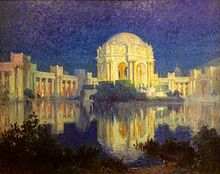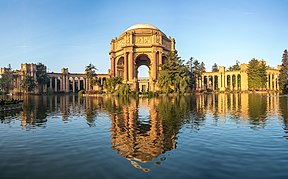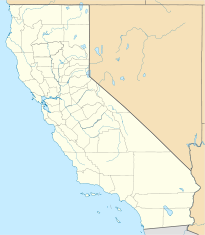Palace of Fine Arts
| Palace of Fine Arts | ||
|---|---|---|
| National Register of Historic Places | ||
| Historic District | ||
|
The Palace of Fine Arts (2020) |
||
|
|
||
| location | Marina District , San Francisco | |
| Coordinates | 37 ° 48 '10.8 " N , 122 ° 26' 52.8" W | |
| Built | 1915 | |
| architect | Bernard Maybeck | |
| NRHP number | 04000659 | |
| The NRHP added | December 5, 2005 | |
The Palace of Fine Arts in the Marina District in San Francisco , California is a building originally constructed for the 1915 Panama-Pacific International Exposition . The central part contains a dome that corresponds to the style of Roman and Greek temples .
history

The building was designed by Bernard Maybeck , a famous architect of the Arts and Crafts Movement . The influences of Roman and Greek architecture are clearly visible, especially the dome in the middle of the complex is reminiscent of temples in Greece or Italy.
The friezes, adorned with many sculptures, on the themes of "Einkehr" and "Meditation" were created by Ulric Ellerhusen . The Palace of Fine Arts, along with the Japanese Tea House, is one of the two buildings that were the only ones not to be demolished after the exhibition. The original intention was to leave the palace, made of perishable building material (a kind of artificial stone), so that it would fall apart because every big city needs its ruins. Because the residents of San Francisco wanted to preserve the new landmark, money was collected as early as the 1930s to gently renovate the building. When the building was actually falling into disrepair in the 1960s, so that repair was no longer possible, the palace was rebuilt with the help of the city and donors with durable building materials. In 1990, at the initiative of neighbors and companies, night lighting was installed, but the building remained in very poor condition. Seismic activity, water and bacteria had attacked the decorations and threatened to decay. A campaign was therefore started in 2003 to finance an extensive renovation. The money was intended to improve earthquake security, repair structural damage, improve the water quality of the pond and also colonize plants and water birds. On December 5, 2005, the Palace of Fine Arts was added to the National Register of Historic Places as a Historic District . The renovation work was completed in early 2009. Meanwhile, Australian eucalyptus trees line the eastern shore of the lagoon and many new animal species have been introduced, including swans, ducks, geese, turtles, frogs, and raccoons.
The exhibition hall, which housed Impressionist paintings during the exhibition , was used by the Exploratorium , a hands-on museum , until January 2013 .
The rotunda with the dome is a popular place for weddings .
gallery
Importance to modern culture
- The palace, especially the dome and the lake in front of it, have often been used as a backdrop in films. Including Vertigo - From the Realm of the Dead by Alfred Hitchcock , The Rock - Rock of the Decision by Michael Bay and Escape into the Future by Nicholas Meyer .
- The Palace of Fine Arts is part of the 49-Mile Scenic Drive .
- A smaller copy of the structure was recreated in the Bayside area of Disney's California Adventure in Anaheim and serves as a cinema.
Web links
Individual evidence
- ^ A b Esther McCoy: Five California Architects . Reinhold Publishing Corporation, New York 1960, p. 6.
- ^ Exhibition of American Sculpture Catalog, 156th Street of Broadway New York, The National Sculpture Society 1923 p.55
- ↑ The Van's History
- ^ The renovation and restoration of the Palace of Fine Arts . LoveThePalace.org. Retrieved July 12, 2009.
- ^ A short history of the Palace of Fine Arts . LoveThePalace.org. Retrieved July 16, 2009.
- ↑ Entry in the National Register Information System . National Park Service , accessed June 1, 2016










